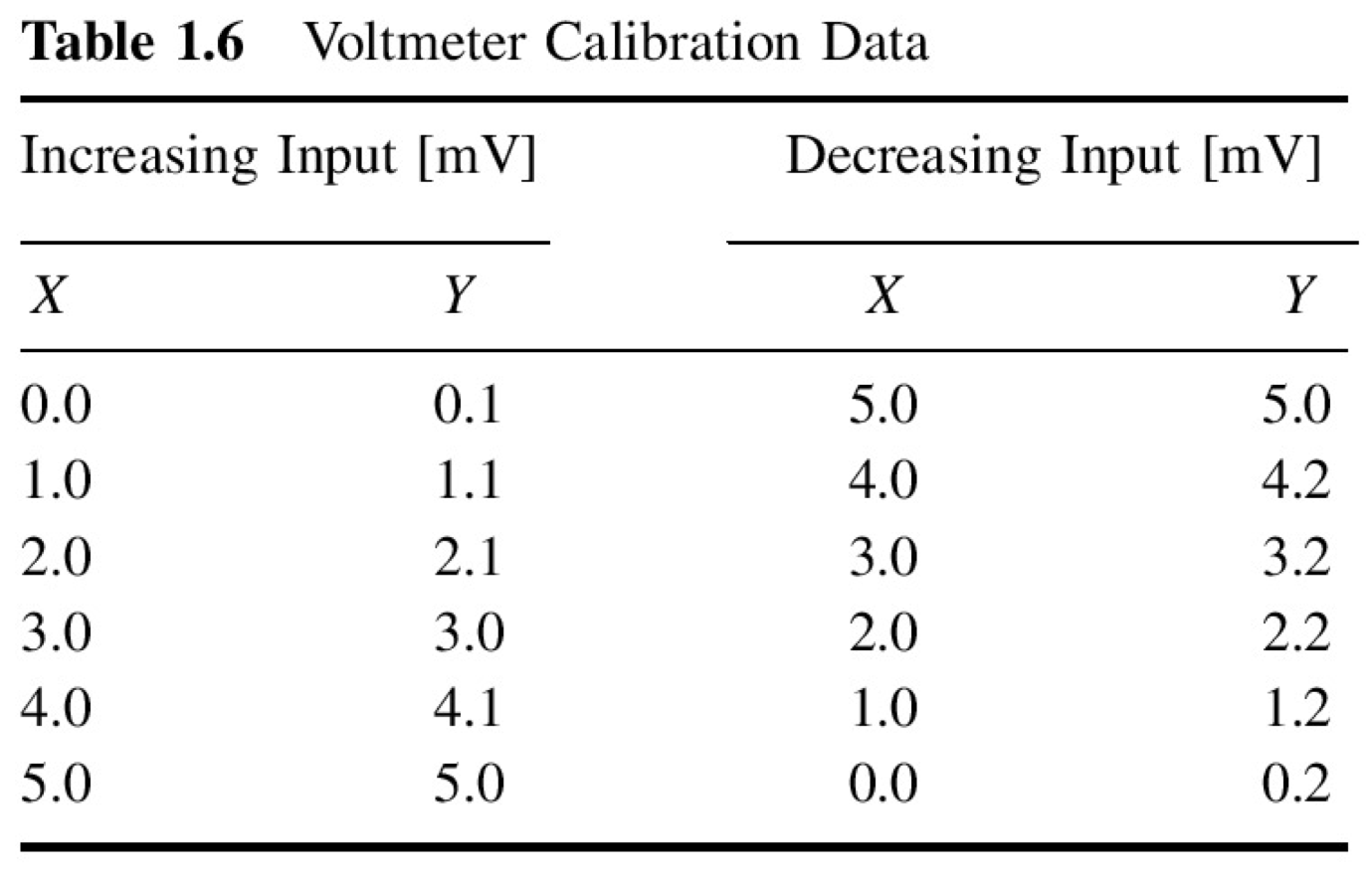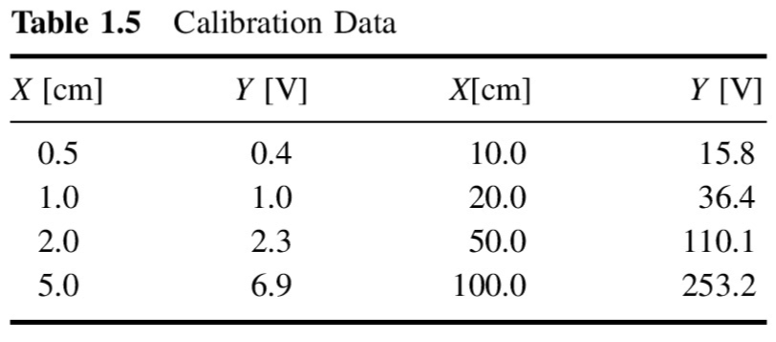Hysteresis and log-log calibration example#
Given a calibration of an instrument for an increasing and decreasing input \(x\) [mV] and output of the instrument \(y\) [mV]
import numpy as np
import matplotlib.pyplot as pl
%matplotlib inline
import matplotlib as mpl
mpl.rcParams['figure.figsize'] = 8, 6
mpl.rcParams['font.size'] = 18
x = np.array([0.0, 1.0, 2.0, 3.0, 4.0, 5.0, 5.0, 4.0, 3.0, 2.0, 1.0, 0.0])
y = np.array([0.1, 1.1, 2.1, 3.0, 4.1, 5.0, 5.0, 4.2, 3.2, 2.2, 1.2, 0.2])
pl.plot(x,y,'o')
pl.xlabel('$x$ [mV]')
pl.ylabel('$y$ [mV]')
Text(0, 0.5, '$y$ [mV]')
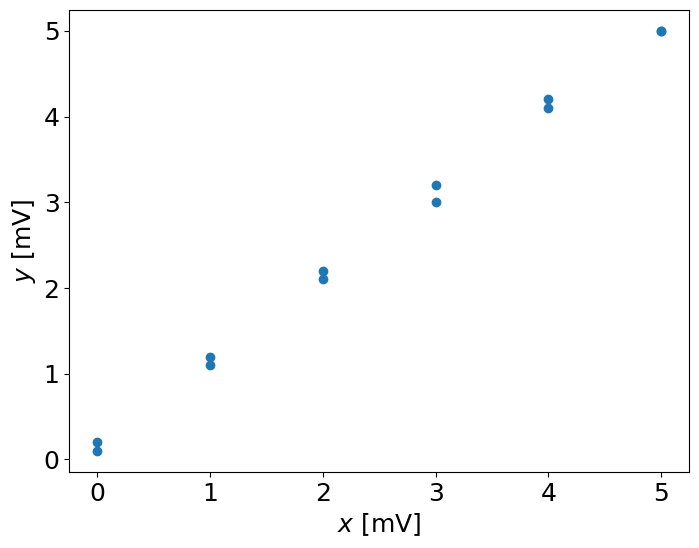
We see the error, but we do not know if it is a random or not
In order to see the hysteresis, we have to set the plot with the lines connecting points:
pl.plot(x,y,'--o')
pl.xlabel('$x$ [mV]')
pl.ylabel('$y$ [mV]')
Text(0, 0.5, '$y$ [mV]')
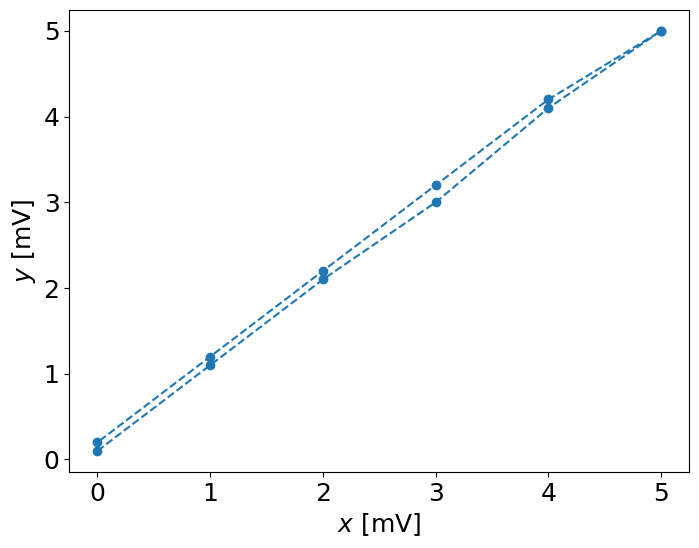
Estimate the hysteresis error:#
\(e_h = y_{up} - y_{down}\)
\(e_{h_{max}} = max(|e_h|)\)
\(e_{h_{max}}\% = 100\% \cdot \frac{e_{h_{max}}}{y_{max}-y_{min}} \)
e_h = y[:6]-np.flipud(y[6:])
print ("e_h =", e_h,"[mV]")
e_h = [-0.1 -0.1 -0.1 -0.2 -0.1 0. ] [mV]
e_hmax = np.max(np.abs(e_h))
print ("e_hmax= %3.2f %s" % (e_hmax,"[mV]"))
e_hmax= 0.20 [mV]
e_hmax_p = 100*e_hmax/(np.max(y) - np.min(y))
print ("Relative error = %3.2f%s FSO" % (e_hmax_p,"%"))
Relative error = 4.08% FSO
Sensitivity error example#
from IPython.core.display import Image
Image(filename='../img/sensitivity_error_example.png',width=400)
x = np.array([0.5, 1.0, 2.0, 5.0, 10.0, 20.0, 50.0, 100.0])
y = np.array([0.4, 1.0, 2.3, 6.9, 15.8, 36.4, 110.1, 253.2])
pl.plot(x,y,'--o')
pl.xlabel('$x$ [cm]')
pl.ylabel('$y$ [V]')
pl.title('Calibration curve')
Text(0.5, 1.0, 'Calibration curve')
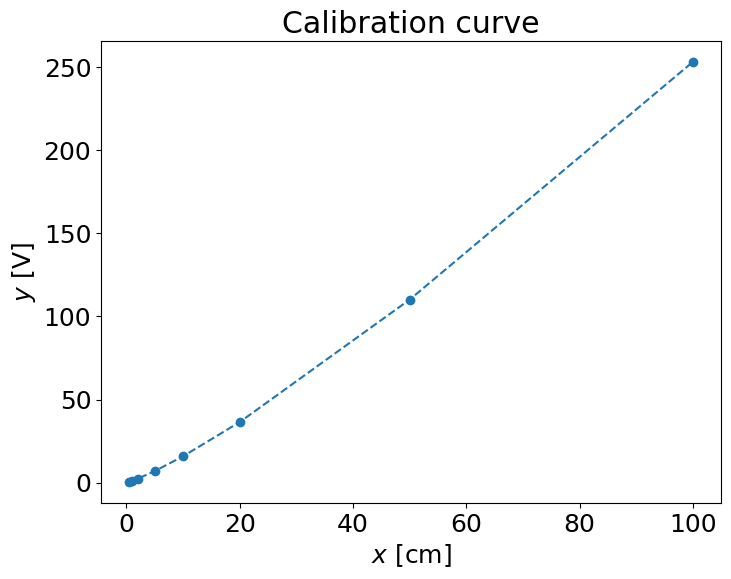
Sensitivity, \(K\) is:
\( K_i = \left( \frac{\partial y}{\partial x} \right)_{x_i} \)
K = np.diff(y)/np.diff(x)
print K
Cell In[12], line 2
print K
^
SyntaxError: Missing parentheses in call to 'print'. Did you mean print(...)?
pl.plot(x[1:],K,'--o')
pl.xlabel('$x$ [cm]')
pl.ylabel('$K$ [V/cm]')
pl.title('Sensitivity')
Instead of working with non-linear curve of sensitivity we can use the usual trick: the logarithmic scale
pl.loglog(x,y,'--o')
pl.xlabel('$x$ [cm]')
pl.ylabel('$y$ [V]')
pl.title('Logarithmic scale')
logK = np.diff(np.log(y))/np.diff(np.log(x))
print( logK)
pl.plot(x[1:],logK,'--o')
pl.xlabel('$x$ [cm]')
pl.ylabel('$K$ [V/cm]')
pl.title('Logarithmic sensitivity')
pl.plot([x[1],x[-1]],[1.2,1.2],'r--')
pl.loglog(x,y,'o',x,x**(1.2))
pl.xlabel('$x$ [cm]')
pl.ylabel('$y$ [V]')
pl.title('Logarithmic scale')
pl.legend(('$y$','$x^{1.2}$'),loc='best')
pl.plot(x,y-x**(1.2),'o')
pl.xlabel('$x$ [cm]')
pl.ylabel('$y - y_c$ [V]')
pl.title('Deviation plot')
# pl.legend(('$y$','$x^{1.2}$'),loc='best')
Regression analysis#
Following the recipe of http://www.answermysearches.com/how-to-do-a-simple-linear-regression-in-python/124/
from scipy.stats import t
def linreg(X, Y):
"""
Summary
Linear regression of y = ax + b
Usage
real, real, real = linreg(list, list)
Returns coefficients to the regression line "y=ax+b" from x[] and y[], and R^2 Value
"""
N = len(X)
if N != len(Y): raise(ValueError, 'unequal length')
Sx = Sy = Sxx = Syy = Sxy = 0.0
for x, y in zip(X, Y):
Sx = Sx + x
Sy = Sy + y
Sxx = Sxx + x*x
Syy = Syy + y*y
Sxy = Sxy + x*y
det = Sx * Sx - Sxx * N # see the lecture
a,b = (Sy * Sx - Sxy * N)/det, (Sx * Sxy - Sxx * Sy)/det
meanerror = residual = residualx = 0.0
for x, y in zip(X, Y):
meanerror = meanerror + (y - Sy/N)**2
residual = residual + (y - a * x - b)**2
residualx = residualx + (x - Sx/N)**2
RR = 1 - residual/meanerror
# linear regression, a_0, a_1 => m = 1
m = 1
nu = N - (m+1)
sxy = np.sqrt(residual / nu)
# Var_a, Var_b = ss * N / det, ss * Sxx / det
Sa = sxy * np.sqrt(1/residualx)
Sb = sxy * np.sqrt(Sxx/(N*residualx))
# We work with t-distribution, ()
# t_{nu;\alpha/2} = t_{3,95} = 3.18
tvalue = t.ppf(1-(1-0.95)/2, nu)
print("Estimate: y = ax + b")
print("N = %d" % N)
print("Degrees of freedom $\\nu$ = %d " % nu)
print("a = %.2f $\\pm$ %.3f" % (a, tvalue*Sa/np.sqrt(N)))
print("b = %.2f $\\pm$ %.3f" % (b, tvalue*Sb/np.sqrt(N)))
print("R^2 = %.3f" % RR)
print("Syx = %.3f" % sxy)
print("y = %.2f x + %.2f $\\pm$ %.3f V" % (a, b, tvalue*sxy/np.sqrt(N)))
return a, b, RR, sxy
print (linreg(np.log(x),np.log(y)))
pl.loglog(x,y,'o',x,x**(1.21)-0.0288)
pl.xlabel('$x$ [cm]')
pl.ylabel('$y$ [V]')
pl.title('Logarithmic scale')
pl.legend(('$y$','$x^{1.2}$'),loc='best')
pl.plot(x,y-(x**(1.21)-0.0288),'o')
pl.xlabel('$x$ [cm]')
pl.ylabel('$y - y_c$ [V]')
pl.title('Deviation plot')
# pl.legend(('$y$','$x^{1.2}$'),loc='best')

